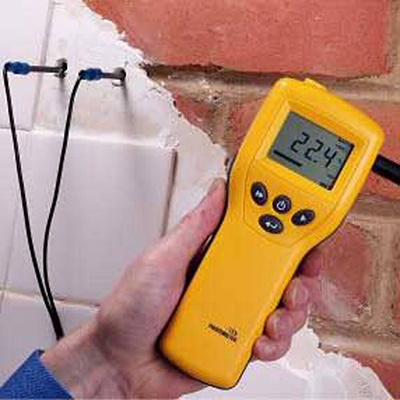Dampness in walls is one of the most common issues faced by UK homeowners. Left untreated, it can lead to mould, structural damage, and costly repairs.
Understanding what is a bad moisture reading for walls is essential if you want to keep your home healthy and protect its value.
At Surveying Cymru, our team of experienced surveyors based in Monmouth provide expert advice and professional damp surveys. Using industry-approved moisture meters, we measure the levels of moisture in walls and explain exactly what those readings mean for your property.

What Does a Moisture Reading Show?
The Basics of Moisture Meter Readings
A moisture meter measures the amount of water present in building materials. For walls, this gives a reading that indicates whether the moisture level is within a safe range or suggests damp issues that need further investigation.
Moisture readings can vary depending on the material tested (plaster, brick, or timber), but generally they fall into three ranges:
- Low (Safe) – Normal background moisture, usually less than 20% in timber or under 16% in plaster and masonry.
- Moderate (Caution) – A higher than normal level that may need monitoring or further checks.
- High (Bad Reading) – Levels above 20–22% in plaster or masonry, or above 20% in timber, are considered problematic and could indicate rising damp, leaks, or condensation issues.
What Is Considered a Bad Moisture Reading for Walls?
Safe vs Problematic Readings
A bad moisture reading for walls typically means the moisture content is higher than what is considered safe for the building material.
For plaster and masonry walls
Anything consistently above 20% moisture content may indicate damp.
For timber within or attached to walls
A reading above 20% suggests a risk of rot or decay.
For painted or finished surfaces
Persistent high readings may explain peeling paint, bubbling wallpaper, or mould growth.
How Chartered Surveyors Interpret Moisture Readings
More Than Just Numbers
Although moisture meters provide instant results, identifying the cause of high readings requires professional expertise. A chartered surveyor goes beyond recording figures, offering informed interpretation within the context of the property.
At Surveying Cymru, our process includes:
- Taking multiple readings across different areas of the property
- Analysing patterns in the results
- Comparing readings with visible signs such as staining, tide marks, or peeling paint
- Providing a clear, written report with professional recommendations
The Benefits of Professional Analysis
Choosing a surveyor ensures:
- Independent, unbiased advice
- Accurate identification of damp sources
- Tailored solutions, not guesswork
- Peace of mind when buying, selling, or maintaining a property
Causes of Bad Moisture Readings in Walls
Common Problems Identified by High Readings
There are several reasons why a wall may show high moisture content:
Rising Damp – Ground moisture moving upward through masonry.
Penetrating Damp – Water ingress through damaged brickwork, roof, or gutters.
Condensation – High indoor humidity leading to moisture build-up on surfaces.
Leaks – Burst pipes, faulty plumbing, or roof leaks seeping into walls.
Long-Term Risks of Ignoring Bad Readings
Failing to act on bad moisture readings can result in:
- Structural damage to brickwork or timber
- Persistent mould growth, affecting health
- Reduced property value when selling
- Increased repair costs over time
Frequently Asked Questions
In most cases, moisture readings below 16% in masonry and plaster are considered safe. Anything above 20% should be investigated.
Not always. Factors like condensation or surface damp can cause temporary spikes, but consistent high readings need professional attention.
DIY damp meters are available, but results can be misleading. A chartered surveyor provides expert interpretation and accurate reporting.
A typical damp survey takes 1–2 hours depending on the size of the property.
Yes, it’s strongly recommended. It ensures hidden damp problems are identified before you commit to purchase.
Book Your Damp Survey with Surveying Cymru
A bad moisture reading for walls can be an early warning sign of serious damp issues. At Surveying Cymru, our expert surveyors provide independent damp surveys to identify and explain what your readings really mean.
Call: 01600 715350 Email: nick@surveyingcymru.co.uk